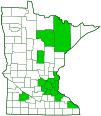fragrant sumac
(Rhus aromatica var. aromatica)
Conservation • Wetland • Description • Habitat • Ecology • Use • Distribution • Taxonomy
Description |
||
Fragrant sumac is an erect, perennial, 20″ to 80″ tall, deciduous shrub that rises on multiple stems from a compact, well developed root system and long, branched, creeping, underground stems (rhizomes). It often forms thickets up to 10′ across. Young stems and twigs are dark reddish-brown and sparsely to densely covered with minute, nonglandular hairs. Older stems are grayish-brown, hairless, and frequently branched. When crushed the stems and leaves have an odor which has been variously described as citrussy, pleasantly bittersweet, very unpleasant, and malodorous. The leaves are alternate and divided into 3 leaflets (ternate). They are on ⅜″ to 1″ long leaf stalks. The leaflets are ¾″ to 2¾″ long, ⅝″ to 2″ wide and variable in shape. The terminal leaflet is rhombic to egg-shaped and stalkless or nearly stalkless. It is angled at the base and pointed at the tip. It is not 3-lobed. The margins have 3 to 6 broad, rounded or pointed teeth per side above the middle and are untoothed toward the base. The upper surface is almost hairless to densely covered with short, fine, grayish hairs. The lower surface is sparsely to densely hairy. Lateral leaflets are similar but smaller and may be less toothed. The outer margin of each lateral leaflet is rounded to the base. The leaves turn shades of orange, red, and purple in the fall. The inflorescence is a ¾″ to 2⅜″ long, ⅜″ to 1 3 ⁄16″ wide branched arrangement (panicle) of several short, ⅜″ to ¾″ long, dense, spike-like clusters of numerous flowers at the end of the stem. The spikes are formed in late summer from buds in the leaf axils of the current year’s growth. They persist through the winter, expand in the spring, and flower from April to May before the leaves expand. Male and female flowers usually, but not always, appear on separate plants. Male flowers appear in catkins, female flowers in clusters. Each flower is tiny, about ⅛″ long and 1 ⁄10″ in diameter, with 5 sepals and 5 petals. Male flowers have 5 stamens, female flowers have 3 styles. The sepals are lance-shaped, 1 ⁄32″ to 1 ⁄16″long, about 1 ⁄32″ wide. They are united just at the base then separated into 5 lobes. They are reddish-brown at the base and have hairs only along the thin margins. The petals are pale yellow to greenish-yellow, oblong egg-shaped, 1 ⁄16″ to ⅛″ long, and rounded at the tip. The inner surface is hairless. The stamens have yellow anthers that are shorter than the filaments. The infructescence is numerous fruits usually coalesced into a dense cluster. The fruits remain on the plant into the winter. Each berry-like fruit (drupe) is red, hairy, and usually not shiny. It is comprised of a 1-seeded stone surrounded by a fleshy middle layer and a thin skin. It is spherical but slightly flattened, 3 ⁄16″ to ¼″ long, and ⅛″ to 3 ⁄16″ wide. It is densely covered with stout, red, glandular hairs, and sparsely to densely covered with fine, white or colorless, nonglandular hairs. The fleshy middle is readily detachable from the stone. |
||
Height |
||
20″ to 80″ |
||
Flower Color |
||
Pale yellow to greenish-yellow |
||
Similar Species |
||
Smooth sumac (Rhus glabra) leaves are pinnately compound and are divided into 11 to 31 leaflets. Staghorn sumac (Rhus typhina) leaves are pinnately compound and are divided into 11 to 31 leaflets. |
||
Habitat |
||
Dry. Prairie ravines, open hillsides, woodland edges and openings, sand dunes. Full sun to partial shade. Sandy or gravelly soil. |
||
Ecology |
||
Flowering |
||
April to May |
||
Pests and Diseases |
||
|
||
Use |
||
Fragrant sumac plant is sold as an ornamental shrub for sides of buildings and for city streets but not often for yards. It is sometimes used for stabilizing embankments. It is widely planted in Minnesota. |
||
Distribution |
||||
|
Sources |
|||
| 4/21/2023 | ||||
Nativity |
||||
Native |
||||
Occurrence |
||||
Fragrant sumac is common in eastern and central United States from Connecticut to Kansas south to Georgia and Texas. In is uncommon in the upper Midwest. |
||||
Taxonomy |
|||
| Kingdom | Plantae (Plants) | ||
| Division | Tracheophyta (Vascular Plants) | ||
| Subdivision | Spermatophytina (Seed Plants) | ||
| Class | Magnoliopsida (Dicots) | ||
Order |
Sapindales (soapberries, cashews, mahoganies, and allies) | ||
Family |
Anacardiaceae (cashew) | ||
| Subfamily | Anacardioideae (cashews, sumacs, and allies) | ||
Genus |
Rhus (sumacs) | ||
| Species | Rhus aromatica (fragrant sumac) | ||
Subordinate Taxa |
|||
There are three varieties of fragrant sumac (Rhus aromatica) in North America. This is the only variety found in Minnesota. |
|||
Synonyms |
|||
Rhus trilobata |
|||
Common Names |
|||
aromatic sumac fragrant sumac lemon sumac polecatbush skunk bush skunkbrush squawbush squaw-bush sweet sumac |
|||
Glossary
Catkin
A slim, cylindrical, drooping cluster of many flowers. The flowers have no petals and are either male or female but not both.
Drupe
A fleshy fruit with usually a single hard, stone-like core, like a cherry or peach; a stone fruit.
Filament
On plants: The thread-like stalk of a stamen which supports the anther. On Lepidoptera: One of a pair of long, thin, fleshy extensions extending from the thorax, and sometimes also from the abdomen, of a caterpillar.
Glandular hairs
Hairs spread over aerial vegetation that secrete essential oils. The oils act to protect against herbivores and pathogens or, when on a flower part, attract pollinators. The hairs have a sticky or oily feel.
Panicle
A pyramidal inflorescence with a main stem and branches. Flowers on the lower, longer branches mature earlier than those on the shorter, upper ones.
Pinnate
On a compound leaf, having the leaflets arranged on opposite sides of a common stalk. On a bryophyte, having branches evenly arranged on opposite sides of a stem.
Rhizome
A horizontal, usually underground stem. It serves as a reproductive structure, producing roots below and shoots above at the nodes.
Sepal
An outer floral leaf, usually green but sometimes colored, at the base of a flower.
Ternate
Refers to leaves that are divided into three leaflets or sections.
Visitor Photos |
|||||
Share your photo of this plant. |
|||||
| This button not working for you? Simply email us at info@MinnesotaSeasons.com. Attach one or more photos and, if you like, a caption. |
|||||
|
|||||
MinnesotaSeasons.com Photos |
|||||
Plant |
|||||
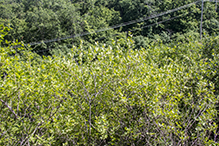 |
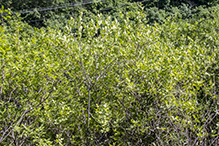 |
||||
Leaves |
|||||
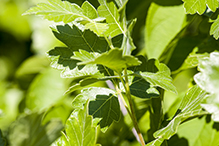 |
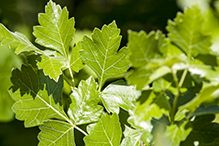 |
||||
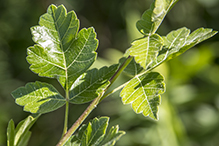 |
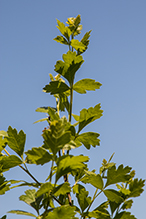 |
||||
Leaflets |
|||||
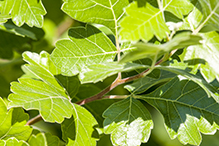 |
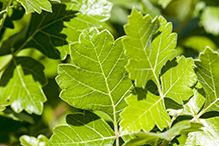 |
||||
Infructescence |
|||||
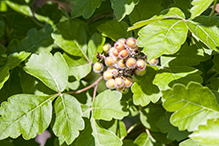 |
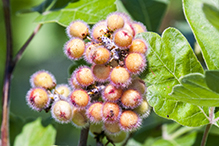 |
||||
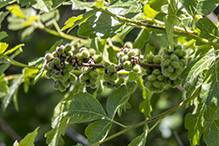 |
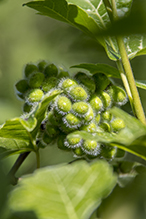 |
||||

Slideshows |
||
| Rhus aromatica Matt Lavin |
||
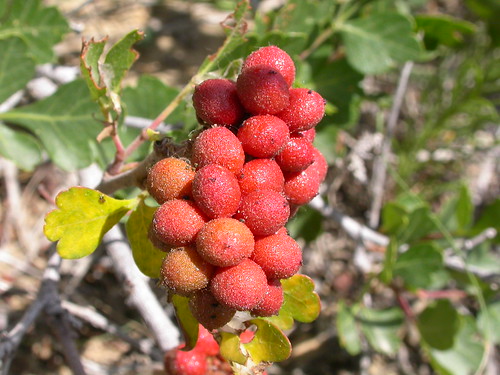
|
||
About
Native shrub 1-2 m tall with trifoliate leaves, leaflets with distinctively lobed margins, clustered of small flowers produced during the spring and early summer often before the leaves are produced, common at lower elevations and on protected south-facing slopes in open arid understory, grasslands, and sagebrush steppe. |
||
| Rhus aromatica Angie Holmberg |
||
About
Published on Jul 31, 2014 Description |
||

Visitor Videos |
|||
Share your video of this plant. |
|||
| This button not working for you? Simply email us at info@MinnesotaSeasons.com. Attach a video, a YouTube link, or a cloud storage link. |
|||
Other Videos |
|||
| Hort 306/608 Plant List 7-1 HD Bush Bu |
|||
About
Uploaded on Oct 19, 2010 Scientific Name: Common Name: Family: 1 Rhus aromatica Fragrant Sumac Anacardiaceae 2 Symphoricarpos orbiculatus Coralberry Caprifoliaceae 3 Cuphea spp. Cuphea Lythraceae 4 Chaenomeles spp. Flowering Quince Rosaceae 5 Forsythia × intermedia Border Forsythia Oleaceae 7 Spiraea spp. Spirea Rosaceae 8 Hydrangea quercifolia Oakleaf Hydrangea Saxifragaceae 9 Hydrangea macrophylla Bigleaf Hydrangea Saxifragaceae 10 Caesalpinia pulcherrima Pride-Of-Barbados Fabaceae |
|||
| Gardening: Edible Plants : How to Grow Sumac (Rhus Aromatica) ehowgarden |
|||
About
Uploaded on Feb 19, 2009 Growing sumac, also known as rhus aromatica, requires a cold climate, and it creates a great ground cover for poor or dry soils. Find out how to grow this low-growing shrub with helpful advice from a sustainable gardener in this free video on gardening. |
|||

Visitor Sightings |
|||||
Report a sighting of this plant. |
|||||
| This button not working for you? Simply email us at info@MinnesotaSeasons.com. Be sure to include a location. |
|||||
|
|||||
MinnesotaSeasons.com Sightings |
|||||

|
Created: Last Updated: © MinnesotaSeasons.com. All rights reserved. |
